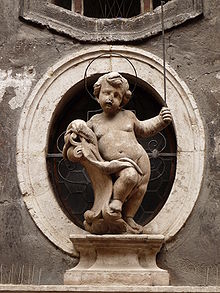
Back Bloedlaster AF Ritualmordlegende ALS فرية الدم Arabic Кръвна клевета срещу евреите Bulgarian Libel de sang Catalan Ritualmordlegende German Zûra goniy DIQ Συκοφαντία του αίματος Greek Akuzo pri ofero de sango EO Libelo de sangre Spanish

| Part of a series on |
| Antisemitism |
|---|
 |
|
|
| Part of a series on |
| Discrimination |
|---|
 |
Blood libel or ritual murder libel (also blood accusation)[1][2] is an antisemitic canard[3][4][5] which falsely accuses Jews of murdering Christians in order to use their blood in the performance of religious rituals.[1][2][6] Echoing very old myths of secret cultic practices in many prehistoric societies, the claim, as it is leveled against Jews, was rarely attested to in antiquity. According to Tertullian, it originally emerged in late antiquity as an accusation made against members of the early Christian community of the Roman Empire.[7] Once this accusation had been dismissed, it was revived a millennium later as a Christian slander against Jews in the medieval period.[8][9] The first examples of medieval blood libel emerged in England in the mid 1100s before spreading into other parts of Europe, especially France and Germany. This libel, alongside those of well poisoning and host desecration, became a major theme of the persecution of Jews in Europe from that period down to modern times.[4]
Blood libels often claim that Jews require human blood for the baking of matzos, an unleavened flatbread which is eaten during Passover. Earlier versions of the blood libel accused Jews of ritually re-enacting the crucifixion.[10] The accusations often assert that the blood of Christian children is especially coveted, and historically, blood libel claims have been made in order to account for the otherwise unexplained deaths of children. In some cases, the alleged victims of human sacrifice have become venerated as Christian martyrs. Many of these – most prominently William of Norwich (1144), Little Saint Hugh of Lincoln (1255), and Simon of Trent (1475) – became objects of local cults and veneration; the cult of Hugh of Lincoln gained the support of Henry III and his son Edward I, giving it official credibility and helping it to be particularly well remembered. Although he was never canonized, the veneration of Simon was added to the General Roman Calendar. One child who was allegedly murdered by Jews, Gabriel of Białystok, was canonized by the Russian Orthodox Church.
In Jewish lore, blood libels served as the impetus for the creation of the Golem of Prague by Rabbi Judah Loew ben Bezalel in the 16th century.[11] The term 'blood libel' has also been used in reference to any unpleasant or damaging false accusation, and as a result, it has acquired a broader metaphoric meaning. However, this wider usage of the term remains controversial.[12][13][14]
- ^ a b Gottheil, Richard; Strack, Hermann L.; Jacobs, Joseph (1901–1906). "Blood Accusation". Jewish Encyclopedia. New York: Funk & Wagnalls.
- ^ a b Dundes, Alan, ed. (1991). The Blood Libel Legend: A Casebook in Anti-Semitic Folklore. University of Wisconsin Press. ISBN 978-0-299-13114-2.
- ^ Turvey, Brent E. Criminal Profiling: An Introduction to Behavioral Evidence Analysis, Academic Press, 2008, p. 3. "Blood libel: An accusation of ritual murder made against one or more persons, typically of the Jewish faith".
- ^ a b Chanes, Jerome A. Antisemitism: A Reference Handbook, ABC-CLIO, 2004, pp. 34–45. "Among the most serious of these [anti-Jewish] manifestations, which reverberate to the present day, were those of the libels: the leveling of charges against Jews, particularly the blood libel and the libel of desecrating the host."
- ^ Goldish, Matt. Jewish Questions: Responsa on Sephardic Life in the Early Modern Period, Princeton University Press, 2008, p. 8. "In the period from the twelfth to the twentieth centuries, Jews were regularly charged with blood libel or ritual murder – that Jews kidnapped and murdered non-Jews as part of a Jewish religious ritual."
- ^ Zeitlin, S "The Blood Accusation" Vigiliae Christianae, Vol. 50, No. 2 (1996), pp. 117–124
- ^ Emanuele D'Antonio, Jewish Self-Defense against the Blood Libel in Mid-Nineteenth Century Italy: the Badia Affair and Proceedings of the Castilliero Trial (1855–56), Quest. Issues in Contemporary Jewish History volume 14, 1 pp. 23–47
- ^ Norman Cohn, Europe's Inner Demons, (1975) Paladin Books 1976 pp. 1–8.
- ^ Albert Ehrman, 'The Origins of the Ritual Murder Accusation and Blood Libel,' Tradition vol. 14, No. 4 Spring 1976 p. 83
- ^ "The life and miracles of St. William of Norwich". 1896.
- ^ "Angelo S. Rappoport The Folklore of the Jews (London: Soncino Press, 1937), pp. 195–203". Archived from the original on 18 April 2011.
- ^ "What does 'blood libel' mean?". BBC. 12 January 2011. Retrieved 16 April 2018.
- ^ Jim Geraghty (12 January 2011). "The Term 'Blood Libel': More Common Than You Might Think". National Review. Retrieved 16 April 2018.
- ^ Boteach, Shmuley (14 January 2011). "Sarah Palin Is Right About 'Blood Libel'". The Wall Street Journal.